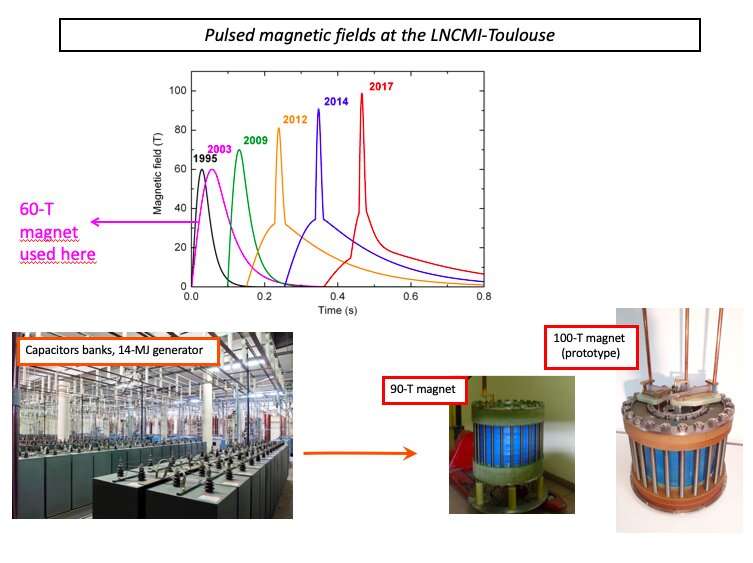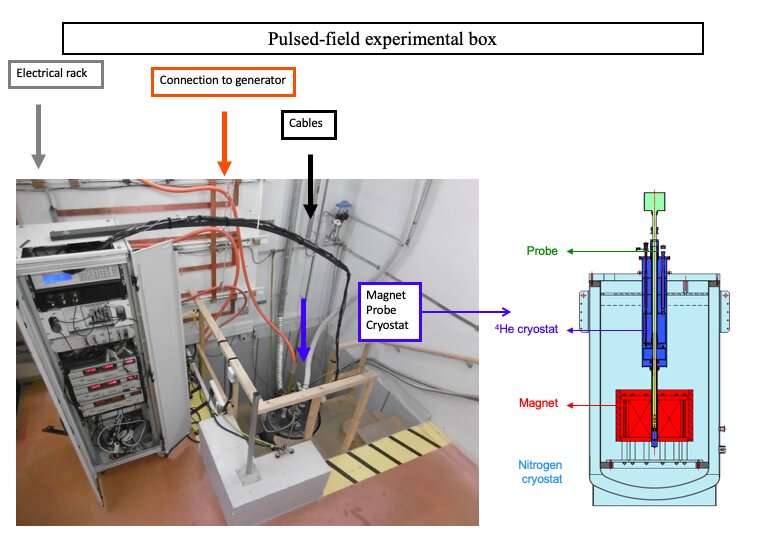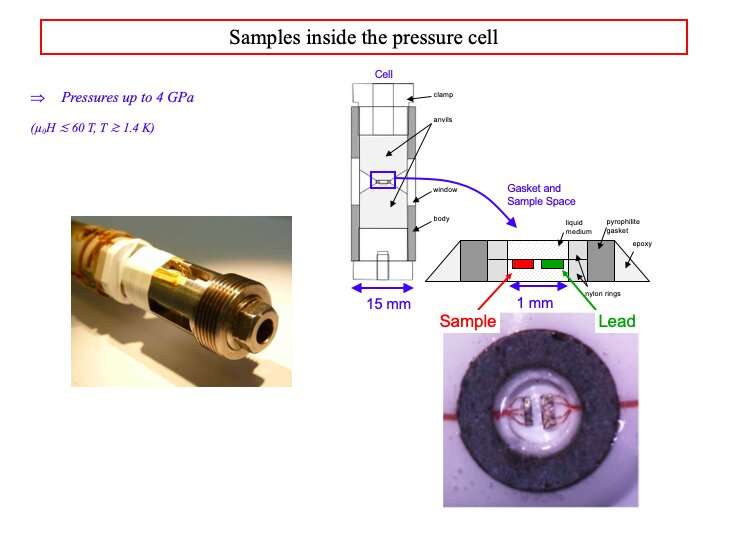July 2, 2020 feature
A three-dimensional phase diagram of heavy-fermion compound with competing quantum phases

URu2Si2 is a metal that belongs to the family of heavy-fermion compounds in which several quantum phases (e.g., magnetism and superconductivity) can compete or coexist. These metals exhibit small energy scales that are easy to tune, a characteristic that makes them ideal for testing new physical ideas and concepts.
For instance, researchers have often used these compounds to test theories related to quantum phase transitions, quantum criticality and unconventional superconductivity. Studying heavy-fermion metals could ultimately unveil new physical properties of other correlated-electron materials that have shown promise for a wide range of applications, such as high-temperature superconductors.
A research team at the National Laboratory of High Magnetic Fields (LNCMI/CNRS) in France and Université Grenoble Alpes, in collaboration with researchers at Okayama University and Tohoku University in Japan, recently carried out a systematic investigation of URu2Si2 under a combination of high pressures and high magnetic fields. Their paper, published in Nature Physics, maps out a phase in the material that is so far poorly understood, delineating a complex three-dimensional phase diagram.
"The case of URu2Si2 is quite particular," William Knafo, one of the researchers who carried out the study, told Phys.org. "A mysterious phase exists in this system, but it has not been identified so far, despite over 30 years of research and the several hundreds of scientific papers published on this topic. The identification of this 'hidden-order' in URu2Si2 remains one of the most challenging problems in solid-state physics."
Instead of trying to understand the mysterious 'hidden-order' phase in URu2Si2 directly, Knafo and his colleagues wanted to gather new elements that could ultimately aid this quest in the future. More specifically, their goal was to determine how the combination of three parameters (i.e., magnetic field, pressure, temperature) influences the hidden-order phase and enables the stabilization of other quantum phases in the material.

"Our experiments are the state-of-the-art of what can be done today by combining three extreme conditions: high magnetic fields, high pressures, and low temperatures," Knafo said. "We generated high magnetic fields at the LNCMI-Toulouse, which is the pulsed-field site of the French National High Magnetic Field Laboratory, which in turn belongs to the European Magnetic Field Laboratory."
In their experiments, Knafo and his colleagues generated pulsed magnetic fields of up to 60 teslas, which is approximately 1 million times greater than the Earth's magnetic field. These pulses had a total duration of 300 milliseconds.
The researchers then used a generator made of capacitor banks, which had a maximum energy of 14 megajoules but was charged at 3 megajoules, to generate several thousands of amperes of current and send it to a resistive magnet. Currently, only a few facilities in the world, situated in Los Alamos (U.S.), Tokyo (Japan), Dresden (Germany), Wuhan (China) and Toulouse, are equipped with the tools necessary to conduct research involving magnetic fields of this intensity.
"We used a pressure cell that can attain pressures up to 4 gigapascals (40 thousand times higher than the atmospheric pressure) inside a standard helium cryostat with temperatures down to 1.4 kelvin, that is, 1.4 degrees above the absolute zero (-273.15 °C)," Knafo said. "We performed electrical resistance measurements on two small samples fitting inside the 1-mm-diameter hole at the heart of the pressure cell. One sample was the investigated material URu2Si2, while the second sample was a pressure gauge."
Finally, the researchers welded four tiny electrical contacts (i.e., wires with a diameter of 15 micrometers) onto their URu2Si2 samples. This ultimately allowed them to measure the material's electrical resistance. To ensure the success of their experiment involving pulsed magnetic fields, the samples and wires they used had to be carefully prepared.

"The main achievement of our study is the determination of the three-dimensional phase diagram of URu2Si2, where the three dimensions are magnetic field, pressure and temperature," Knafo said. "We obtained the boundaries of the hidden-order phase, but also those from other quantum phases in this system: a spin-density wave, antiferromagnetism, polarized paramagnetism etc."
The researchers observed that at high pressures, the field-induced spin-density wave and hidden-order phases disappeared from URu2Si2, yet it exhibited antiferromagnetism. Moreover, they showed that a large amount of phase boundaries in the material are controlled by the field and pressure dependence of a specific parameter.
The findings gathered by Knafo and his colleagues set new constraints that could ultimately inform existing or emerging theories about electronic correlations and ordered phases in URu2Si2. More specifically, the 3-D phase diagram outlined in their paper could be an important step forward in trying to model and understand the material's elusive hidden-order phase, which could in turn help to unveil new physics.
"We will now continue our investigation of heavy-fermion materials," Knafo said. "Our present works focus on the new material UTe2, where a spectacular and rare phenomenon has been observed: superconductivity induced by a magnetic field. This new system is one of the best illustrations of the interplay between magnetism and superconductivity in heavy-fermion materials."
More information: W. Knafo et al. Destabilization of hidden order in URu2Si2 under magnetic field and pressure, Nature Physics (2020). DOI: 10.1038/s41567-020-0927-4
Journal information: Nature Physics
© 2020 Science X Network





















